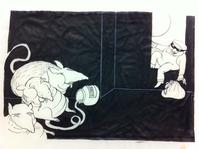One of the great things about being an archivist in the grand “Age of the Internet” is how easy it is to find other archives and communicate with other archivists. This comes in handy when processing manuscript collections; just because we have some material from a given author doesn’t mean we have all of the extant material. Fret not, however, for the material is not lost to the ether: finding it--and the archivists (or curators or librarians) who have it--is often a simple search away.
While processing the Tomi Ungerer papers earlier this fall we uncovered the final art for Basil Ratzki, a vividly imagined story about the dangers for rats who dare to be friendly to humans. Or so we guessed: the illustrations were unlabeled, unpaginated, and missing the accompanying story. For all we knew, the illustrations could have been significantly altered before publication, making them not the “final art” at all. It is surprisingly difficult to reconstruct the art for a children’s book without having the actual children’s book. Did the illustration of the menacing, obese rats ignoring a not-so-stealthy burglar come before or after the one of the town bulldozing dozens of rats? Basil Ratzki was only published in Germany and is out of print today, but thanks to tools like WorldCat (a worldwide online public access catalog) and the omnipresent Google, we were able to find Fr. Greg Carlson’s Fable Collection at Creighton University. Fr. Carlson is an enthusiastic collector, and he was happy to lend us the copy of Basil Ratzki he had donated to Creighton to help put our collection in order. As it turns out, the obese rats came before the bulldozer.
More recently, I have been processing the Frederick R. Gardner collection of Robert Lawson. Robert Lawson (1892-1957) was a prolific author and illustrator, but is perhaps most beloved for his art for The Story of Ferdinand. While researching the history of the collection, I discovered that the Free Library had previously borrowed some original Lawson art from Emporia State University. Emporia’s May Massee collection includes materials from Ms. Massee’s noteworthy career as a children’s book editor at Doubleday and Viking Press. She was also Lawson's longtime editor. In 1977, Emporia State had lent us some of the artwork for Rabbit Hill for a major exhibit celebrating our Lawson acquisition. A few quick emails to their archivist and the May Massee collection item-level catalog (a thick, hardbound book) was on its way to Philadelphia, improving my knowledge of Lawson’s work and the context for our collection. And if you’ve ever had the good fortune to sit next to an archivist at your local bar, you’ll know that context is something we’re pretty enthusiastic about.
Less than six months into the “Milestones in 20th Century American Children’s Literature” project, we’ve already greatly benefitted from the help of other archivists and collectors. As a result of the information and help we’ve received, we will be able to better understand our own project holdings and, in turn, better describe them for our users. A big thank you to all of our colleagues!
- Caitlin Goodman
Have a question for Free Library staff? Please submit it to our Ask a Librarian page and receive a response within two business days.


